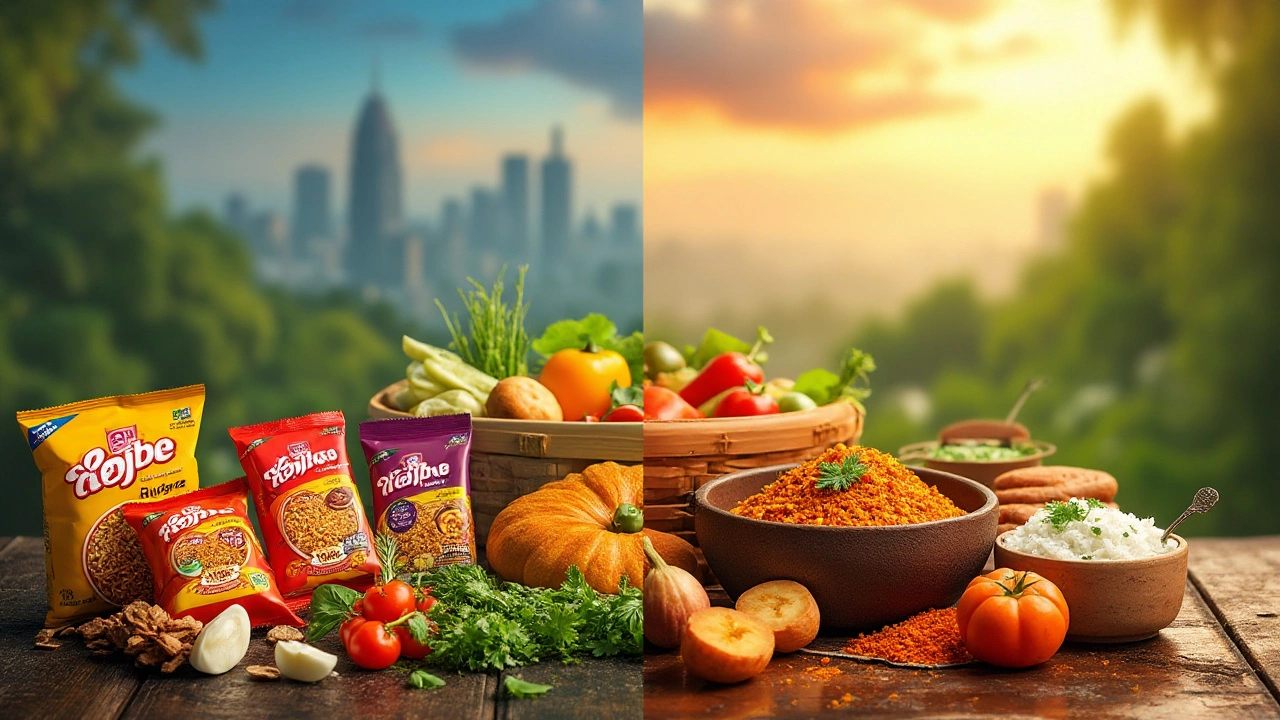Exploring the Unhealthiest Food Choices from Food Processing Units

The world of food processing is vast and varied, offering a plethora of convenient options for individuals leading busy lives. However, amid this convenience lies a hidden danger—the rise of foods that are alarmingly unhealthy. These products often grace the shelves of supermarkets, adorned with appealing packaging but brimming with ingredients that can harm our health in the long run.
To navigate this complex food landscape, it's crucial to understand what processed foods are and why some stand out as particularly harmful. Ingredients such as trans fats, excessive sugars, and high levels of sodium are just a few culprits that contribute to the negative impact these foods can have on our bodies. Knowing how these elements affect your health is the first step toward making better dietary choices.
By educating yourself on what goes into these processed products, you're better equipped to select healthier options, reducing the risks associated with their consumption. Let's take this journey together, uncovering the secrets of food processing units and emerging with knowledge that can lead to a healthier, more mindful eating lifestyle.
- Understanding Food Processing
- Identifying Unhealthy Ingredients
- The Health Risks of Processed Foods
- Making Healthier Choices
Understanding Food Processing
Food processing is an integral part of the modern-day food supply chain. This extensive process involves transforming raw ingredients into marketable food products that have a longer shelf life, better taste, or easier preparation. The journey begins at the very first step, where agricultural products are transformed into edible commodities and ends when these products reach your grocery store. As much as this process does add conveniences, it often comes at the cost of reduced nutritional value. Several known methods are employed, such as canning, freezing, drying, and adding preservatives, each impacting the food’s natural composition differently.
The primary aim of food processing is to ensure food safety and extend its usability. This is achieved by eliminating or slowing down factors that cause spoilage, like bacteria and fungi. Nevertheless, a significant drawback is the stripping away of essential nutrients like vitamins and minerals during such processes. Take, for example, fruits and vegetables. Often, they undergo blanching—a short-term exposure to steam or hot water—to inactivate enzymes before canning, but this process can leach precious nutrients. According to a nutritional study from the University of California, blanching can cause a loss of up to 50% of vitamin C in certain vegetables like spinach and peas.
Another layer to consider is the interaction of additives and preservatives. Manufacturers frequently use these substances to maintain food quality and taste; however, some can be detrimental to health. For instance, trans fats, a type often used to extend the shelf life of baked goods, have been clearly linked to heart disease. In fact, the American Heart Association emphasizes staying clear of foods with partially hydrogenated oils as a means to avoid trans fats. A processed food’s ingredient list can look more like a chemical experiment than something one would wish to consume.
"There is no single factor driving higher rates of chronic disease than the food that we eat," notes expert Dr. Mark Hyman in his book on functional medicine.
Despite these concerns, not every aspect of food processing is inherently negative. Pasteurization, for instance, has significantly reduced foodborne illnesses by killing harmful bacteria in milk and juices without altering their nutritional benefits. It highlights how food processing can indeed play a role in enhancing food safety when applied judiciously. Understanding these nuances offers consumers the knowledge required to discern between beneficial and detrimental processed products.
Moreover, the economic impact of food processing on the global stage cannot be overlooked. It provides opportunities for food exportation, employment, and regional growth, thus supporting large sections of the population. A report released in 2023 indicated that the global food processing market was valued at over $2 trillion, showcasing its immense scale and influence. As we dive deeper into the promises and pitfalls of processed foods, it becomes apparent that informed decisions are crucial, not just for personal health but also for the broader socio-economic fabric.

Identifying Unhealthy Ingredients
Purely from a nutritional perspective, knowing the ingredients that classify foods as unhealthy is fundamental to making more informed dietary decisions. When it comes to processed food, three main culprits stand out due to their detrimental effects on health. These are trans fats, excessive sugars, and a high level of sodium, each playing a significant role in the decline of nutritional quality. Trans fats, often listed as partially hydrogenated oils on labels, are notorious for their ability to increase bad cholesterol levels while lowering good cholesterol. A delve into its history reveals that these fats were largely utilized in the mid-20th century for their ability to extend the shelf life of food products. However, their impact on coronary health far outweighs this benefit.
Trans Fats and Their Impact
Trans fats, predominantly found in fried foods, baked goods, and margarine, continue to influence health negatively regardless of their reduced usage in some regions. Studies confirm that even small quantities can worsen one's heart health. For instance, a study published in the New England Journal of Medicine found that a 2% increase in energy intake from trans fats increased coronary heart disease risk by 23%. This revelation prompts more consumers to scrutinize product labels closely, as being aware of such information can empower individuals to make healthier choices.
"Understanding their potential impact on health, we encourage our patients to avoid trans fats whenever possible," says Dr. Caroline Smith, a leading cardiologist.
High Sugar Content
Next in line is the alarming amount of sugar found in many processed items. Sugar isn't just in obvious sweets but also in various foods like sauces, breads, and snack items, leading to a consumption overload without us even realizing. This stealthy invasion of sugar can lead to weight gain, insulin resistance, and an increased risk of type 2 diabetes. The World Health Organization recommends a sugar intake that constitutes only 10% of your total daily energy. Yet, many processed foods contribute to surpassing these limits effortlessly. To visualize this, consider that a can of soda typically contains around 39 grams of sugar, which is already above the WHO's recommended limit for many people.
Sodium Levels
Sodium, although essential in small amounts for body function, is consumed at dangerously high levels through processed foods. The likes of pre-packaged meals, canned goods, and savory snacks often contain sodium as a preservative, significantly boosting daily intake. The NHS suggests adults should eat no more than 2.4 grams of sodium daily, equating to 6 grams of salt, but many processed items lead to this amount being doubled. Reading labels and opting for low-sodium versions of your favorite foods can drastically slash sodium consumption and promote better heart health. The consistent high intake of sodium is linked to elevated blood pressure, a leading driver of heart disease and stroke.
| Ingredient | Recommendation | Common Sources |
|---|---|---|
| Trans Fats | 0% (avoid) | Fried foods, baked goods |
| Sugar | <10% daily energy | Soda, snacks, bread |
| Sodium | 2.4g daily | Canned goods, pre-packaged meals |
Equipped with this knowledge, you are more prepared to assess food labels critically, ensuring that conscious decisions steer your diet away from unhealthy food. By understanding and identifying these hazardous ingredients, we can chart a path toward a healthier you and a future that's not overshadowed by dietary pitfalls.

The Health Risks of Processed Foods
In our modern dietary landscape, the convenience of processed foods has come at a significant price to health. These foods, often loaded with preservatives and artificial ingredients, pose a myriad of health risks that are difficult to overlook. One of the most pressing concerns is the high presence of trans fats, which have been linked to an increased risk of heart disease. These are created through a process called hydrogenation, which helps preserve the product but often at the expense of our heart health. Alongside trans fats, you'll often find these foods contain excessive amounts of sugar and sodium, both of which can wreak havoc on our bodily systems when consumed in large quantities.
Chronic consumption of these overly unhealthy foods can lead to lifestyle diseases such as obesity and type 2 diabetes. A diet high in processed foods can also have adverse effects on mental health. Studies have shown that individuals who frequently consume fast foods and commercial baked goods may be at a higher risk of depression. This connection could be due to the low nutritional value of the foods, as crucial vitamins and minerals are often stripped away during processing and replaced with unhealthy additives. Detrimentally, these habits begin forming early in life as children exposed to processed diets often show increased rates of mood disorders in adolescence and adulthood.
Moreover, there's evidence suggesting that a diet rich in processed foods can contribute to digestive issues. Fiber is an essential nutrient largely removed in processed foods, leading to issues like constipation and other gastrointestinal discomforts. Fiber helps keep our digestive system operating smoothly, and without it, our overall digestive health suffers greatly. One cannot ignore the chemical additives used for flavor, preservation, and coloring, which are often not tested long-term for their health effects. Over time, they may contribute to a greater risk of developing various cancers.
"While convenient, the habitual consumption of ultra-processed foods poses a significant threat to physical and mental well-being," says Dr. Marion Nestle, a respected nutritionist and public health advocate.
Despite the negative connotations, not all processed foods are public enemy number one. The key lies in moderation and making informed choices. However, it's important to note that this is not just about personal responsibility. There is a wider issue at play involving accessibility and affordability. For many, ultra-processed foods are the most economical choice available, a fact that should fuel our push towards demanding more nutritious options that are accessible and affordable for everyone.

Making Healthier Choices
When standing amidst the enticing aisles of vibrant, pre-packaged delicacies, it might feel daunting to pick out options that align with a healthier lifestyle. The colorful labels often obscure a reality inside these products—where sugar, saturated fats, and sodium reside in quantities that would surprise even the most diligent label-reader. To shift toward healthier choices, it starts with becoming a savvy shopper. Start by understanding ingredient lists; aim for products with fewer ingredients and those that you can recognize as real food. Remember, if you need a dictionary to decode it, your body probably doesn’t need it, either.
One good strategy is to shop the peripheries of the supermarket where fresh produce is typically lined up. Fresh fruits and vegetables are your best friends, offering a bounty of nutrients without the hidden, processed pitfalls. Incorporating these in your meals can drastically reduce your intake of unhealthy processed options. Also, consider embracing whole grains over refined ones. For example, switching from white rice and bread to their whole-grain counterparts offers more fiber, which is key to better digestion and satiety.
Cooking at home is another wonderful way to ensure you're eating healthier. By preparing your meals, you have complete control over what goes inside your dishes. Experiment with new recipes, utilizing a wide variety of unprocessed ingredients. This not only supports better nutrition but can also turn into a creative and fulfilling activity. Keep your pantry stocked with basics like beans, lentils, nuts, and seeds for quick, nourishing options.
Making informed decisions requires education and awareness. Being conscious of serving sizes and daily recommended values for nutrients is important. Take, for instance, the guideline by the World Health Organization that recommends our sugar intake be less than 10% of total energy intake. This translates into a maximum of around 50 grams—or about 12 teaspoons an adult. Such information helps in gauging how processed foods measure up during our selection process.
For those wondering about indulgence, remember that balance is crucial. It's alright to feast on a guilty pleasure occasionally but strive to fill your diet primarily with wholesome, less-processed foods. Studies have consistently shown that diets high in whole foods contribute to lower risks of chronic diseases compared to those dominated by processed variants. So, letting informative knowledge guide your eating habits can pave the way for substantial long-term health benefits.
In the words of Michael Pollan, a respected food journalist and author,
“Eat food, not too much, mostly plants.”His sage advice echoes the ethos of making healthier choices in the simplest terms. By focusing on minimally processed forms, nature’s offerings naturally cater to our nutritional needs without over-complicating the eating process. Embrace these guidelines, and you'll likely find both vitality and pleasure in the simplicity of health-conscious, mindful eating.